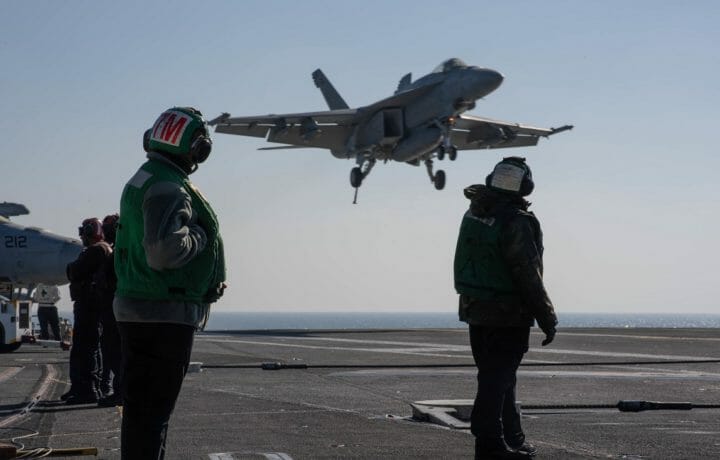The United States Navy announced that one of its Boeing F/A-18 Super Hornet carrier-based fighters was “lost” at sea. The multirole aircraft fell off the Nimitz-class nuclear-powered aircraft carrier USS Harry S. Truman (CVN-75) while being towed to the hangar bay.
The aircraft, assigned to Strike Fighter Squadron 136 (VFA-136), was being towed when the move crew lost control. All personnel were immediately accounted for, while one sailor sustained a minor injury.
“Sailors towing the aircraft took immediate action to move clear of the aircraft before it fell overboard. An investigation is underway,” the U.S. Navy said in a statement. “The Harry S. Truman Carrier Strike Group and embarked air wing remain fully mission capable.”
An investigation is underway.
A Cursed Deployment?
CVN-75 arrived in the Middle East last November and has recently been engaged in the ongoing strikes against the Iranian-backed Houthi militants in Yemen as part of Operation Rough Rider. The warship’s time in the region has not been without incident.
In December, another F/A-18 Super Hornet was shot down in a “friendly fire incident,” after the Ticonderoga-class guided-missile cruiser USS Gettysburg (CG-64), one of the warships in the Carrier Strike Group (CSG), mistakenly fired on the aircraft for an enemy.
Two months later, after USS Harry S. Truman completed a resupply at U.S. Naval Support Activity (NSA) Souda Bay, Greece, the carrier collided with a 53,000-ton Panamanian-flagged cargo ship, Besiktas-M, while operating in the Mediterranean Sea near Port Said, Egypt.
The carrier underwent emergency repairs at Souda Bay. Captain David Snowden was relieved of command, while Captain Chris Hill was named interim commander. Hill was well aware of the situation in the region, having previously commanded the Nimitz-class carrier USS Dwight D. Eisenhower (CVN-69), which spent much of her nearly nine-month deployment protecting commercial shipping from the Iran-backed Houthis in Yemen.
Pressures of Combat?
The U.S. Navy has maintained a near-constant presence in the Middle East since Hamas launched its attack into southern Israel in early October 2023, igniting the ongoing conflict in Gaza.
The sea service also extended the deployments of the USS Gerald R. Ford (CVN-78), and the CVN-69, while last September, the USS Theodore Roosevelt (CVN-71) departed the region eight months into her deployment but only after then-U.S. Secretary of Defense Lloyd Austin ordered the USS Abraham Lincoln (CVN-72) to rush to the Middle East from the West Coast of the United States.
The past two-and-half years have seen hundreds of missiles and drones launched at commercial vessels as well as the U.S. Navy’s warships. The ongoing operations have been described as the most intense for the U.S. Navy since the Second World War.
The Pentagon also increased the number of military aircraft in the region, including an undisclosed number of F-22 Raptors, F-15E Strike Eagles, F-16 Fighting Falcons, and A-10 Thunderbolt II aircraft. Last month, six United States Air Force B-2 Spirit bombers were deployed to the Indian Ocean island of Diego Garcia, ready to strike targets in Yemen, but also likely to be employed to bomb Iran’s nuclear facilities if Washington is unable to reach an agreement with Tehran over the state of the Islamic Republic’s nuclear program.
Search Suspended for Missing Sailor
The U.S. Navy also announced last week that it had suspended the search for a sailor from the USS Nimitz (CVN-68) after the aircraft carrier concluded a scheduled port call to Naval Base Guam.
Over five days, the U.S. Navy carried out an extensive search mission of more than 11,000 square nautical miles.




